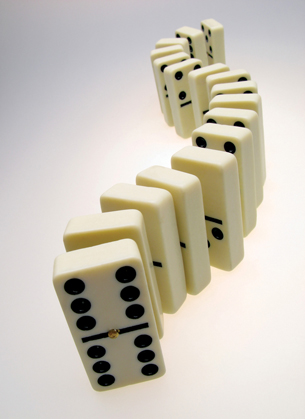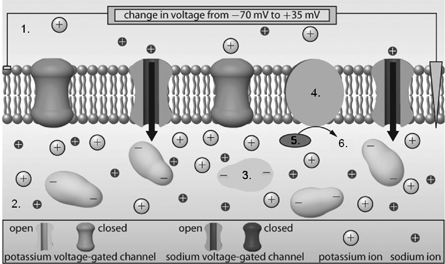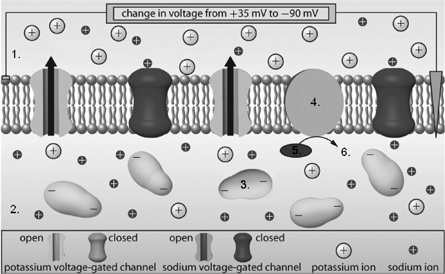Module 1
1. Module 1
1.48. Page 4
Module 1—The Nervous System
 Self-Check
Self-Check

© Andriy Solovyov/shutterstock
SC 6. One way to model the action potential is to line up several dominoes and initiate a cascade event, in which each successive domino knocks down the next domino.
- In this model, the hand provides the initial energy. What provides the initial energy in a neural impulse?
- The finger has to contact the first domino just hard enough to get it to fall. Which action does this represent in a real neuron?
- Once the dominoes start to fall, they all fall in succession. What does this action represent in the real neuron?
- The dominoes always fall in one direction. Contrast this with the direction of impulse transmission in a real neuron.
- No matter how many times the dominos fall, they always move at the same speed and intensity. What principle does this represent in the real neuron?
Check your answers before proceeding further in this lesson.
 Self-Check Answers
Self-Check Answers
SC 6.
- To start an action potential or a nerve impulse, a stimulus such as light energy, sound vibration, hot or cold, or a chemical that is intense enough to cause the neuron to reach threshold potential (to cause enough sodium gates to open to begin depolarization) is needed.
- This demonstrates part of the all-or-none response—the action potential is either generated by the stimulus or it isn’t (just like the domino either falls or it doesn’t). The stimulus must reach threshold potential or depolarization will not occur.
- In a real neuron, this would be described as a wave of depolarization along an axon or the propagation of the action potential along the neuron. The impulse travels in only one direction in a neuron as well.
- The wave of depolarization proceeds in one direction, like the dominoes fall in one direction. The previous domino pushes on the next one, causing it to fall and so on. In the neural membrane, once the sodium gates open and sodium ions rush into the axon, they cannot diffuse out, so they diffuse along the axon—and when they reach the next section, the positive charges reduce the net negative charge, thereby depolarizing the next section to threshold and stimulating more depolarization. Since an action potential just occurred in the previous section, and the net negative charge has been reduced, the impulse cannot go backward. In the domino analogy, the previous domino has fallen and it cannot fall again.
- The dominoes always fall at the same speed and intensity. This event is also explained by the all-or-none response in a neuron. An axon cannot respond with a mild or a strong response; it can only respond or not respond. A stimulus that is strong enough to reach the threshold potential in the neuron will generate an action potential, and a wave of depolarization will be initiated. The depolarization in the next section does not occur faster or slower or more powerfully than in the last section, it just occurs.
Depolarization of the Neuron

Adapted from Inquiry into Biology (Whitby, ON: McGraw-Hill Ryerson, 2007), BLM 11.1.9. Reproduced by permission.
SC 7. What is illustrated by number 1? Explain what is happening in number 1.
SC 8. What is shown by number 2? Explain what is happening to number 2 at this time.
SC 9. What is indicated by number 3? Identify one characteristic of number 3 and identify the function of number 3.
SC 10. What structure is shown by number 4? Explain its function.
SC 11. What are numbers 5 and 6? What is their function in nerve impulse transmission?
 Self-Check Answers
Self-Check Answers
SC 7. This shows a stimulated portion of a neuron membrane. The sodium gates are open and sodium ions are rushing to the inside of the neuron. The potassium gates are closed. The outside of the neuron is becoming negatively charged and the inside is becoming positively charged.
SC 8. The fluid inside the neuron (intracellular fluid) shows a high concentration of K+ ions and an increasing concentration of Na+ ions. The intracellular fluid is becoming positively charged.
SC 9. Large negatively charged protein particles, which are too big to move across the selectively permeable membrane, contribute to the voltage difference across the neuron membrane.
SC 10. This is a carrier protein embedded in the neuron membrane that functions in the sodium-potassium ion pump by using the energy of ATP to move three Na+ ions to the outside of the neuron and two K+ ions to the inside of the neuron. This maintains the difference in voltage across the membrane.
Repolarization of the Neuron

Adapted from Inquiry into Biology (Whitby, ON: McGraw-Hill Ryerson, 2007), BLM 11.1.9. Reproduced by permission.
SC 12. What is shown by number 1 in this diagram? How do you know this?
SC 13. What is happening in number 2 in this process?
SC 14. What is the function of structure 3?
SC 15. What functions does structure 4 serve in the process illustrated?
SC 16. What do 5 and 6 tell you about structure 4?
 Self-Check Answers
Self-Check Answers
SC 12. This shows a portion of the neural membrane undergoing repolarization. The sodium gates are closed and the potassium gates are open. K+ ions diffuse to the outside of the neuron and cause the outside to become positively charged.
SC 13. The fluid inside the neuron (intracellular fluid) is showing that Na+ ions are trapped on the inside of the neuron, and the inside of the neuron is becoming negatively charged.
SC 14. Large, negatively charged protein particles, which are too big to move across the selectively permeable membrane, contribute to the voltage difference across the neuron membrane.
SC 15. The sodium-potassium ion pump uses energy in the form of ATP to move three Na+ ions to the outside and two K+ ions to the inside to re-establish both the resting membrane potential and the correct distribution of ions.
If your answers are similar to the suggested answers, you are ready to submit an assignment to your teacher to show your understanding. If you do not understand the concepts, you need to access your teacher for further discussion before attempting the assignment.
 Module 1: Lesson 7 Assignment
Module 1: Lesson 7 Assignment
Retrieve the copy of the Module 1: Lesson 7 Assignment that you saved to your computer earlier in this lesson. Complete Part 1 or Part 2, both of which deal with the concept of action potential. In Part 1 you may choose to analyze a graph and answer questions based on the graph. In Part 2 you may choose to summarize the events of the action potential. Save your completed assignment in your course folder. You will receive instructions about when to submit your assignment to your teacher later in this lesson.